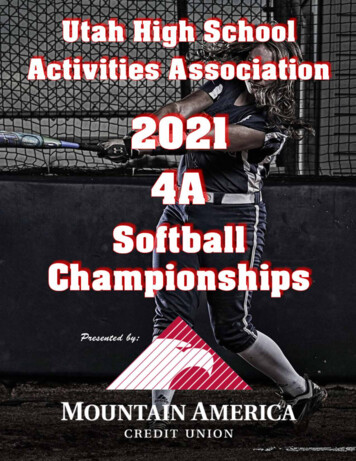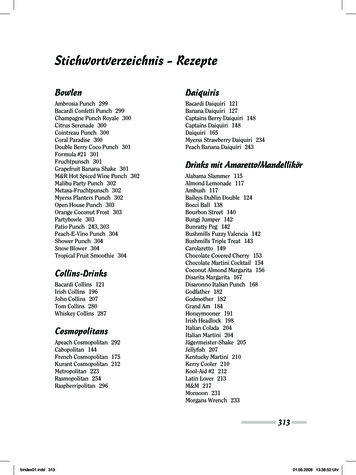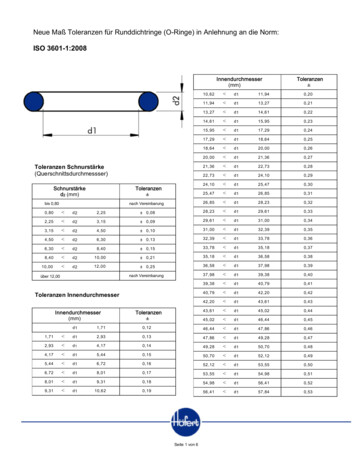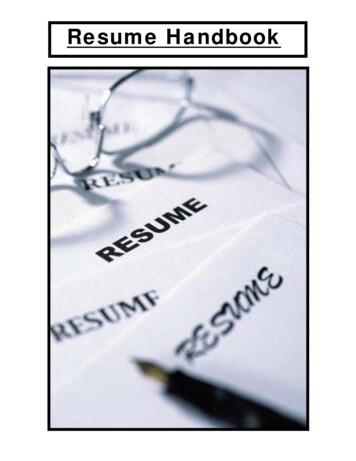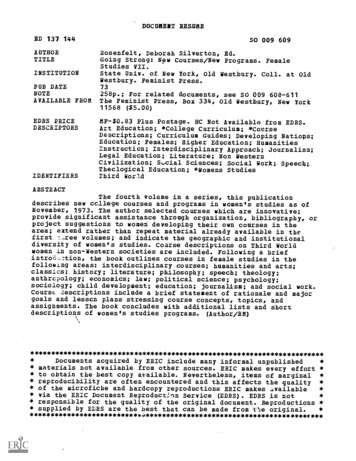
Transcription
DOCUMENT RESUMEED 137 144SO 009 609AUTHORTITLEINSTITUTIONPUB DATENOTEAVAILABLE FROMEDES PRICEDESCRIPTORSRosenfelt, Deborah Silverton, Ed.Going Strong: New Courses/New Programs. FemaleStudies VII.State Univ. of New York, Old Westbury. Coll. at OldWestbury. Feminist Press.73258p.; For related documents, see SO 009 608-611The Feminist Press, Box 334, Old Westbury, New York11568 ( 5.00)EF- 0.83 Plus Postage. HC Not Availablo from EDRS.Art Education; *College Curriculum; *CourseDescriptions; Curriculum Guides; Developing Nations;Education; Females; Higher Education; HumanitiesInstruction; Interdisciplinary Approach; Journalism;Legal Education; Literature; Non WesternCivilization; S1/41cial Sciences; Social Work;. Speech;.IDENTIFIERSTheological Education; *Womens StudiesThird WoradABSTRACTThe fourth volume in a series, this publicationdescribes new college courses and programs in women's studies as ofNovember, 1973. The author selected courses which are innovative;provide significant assistance through organization, bibliography, orproject suggestions to women developing their own courses in thearea; extend rather than repeat material already, available in thefirst 7ree volumes; and indicate the geographic and institutionaldiversity of womenss studies. Coarse descriptions on Third Worldwomen in non-Western societies are included. Following a briefintro6,3tion, the book outlines courses in female studies in thefollowing areas: interdisciplinary courses; humanities and arts;classics; history; literature; philosophy; speech; theology;anthropology; economics; law; political science; psychology;sociology; child development; education; journalism; and social work.Course descriptions include a brief statement of rationale and majorgoals and lesson plans stressing course concepts, topics, andassignments. The book concludes with additional lists and shortdescriptions of women's studies programs. *********************************Documents acquired by ERIC include many informal unpublished* materials not available from other sources. ERIC makes every effort ** to obtain the best copy available. Nevertheless, items of marginal ** reproducibility are often encountered and this affects the quality ** of the microfiche and hardcopy reproductions ERIC makes vailable** via the ERIC Document Reproduct.iln Service (EDRS). EDRS is not* responsible for the quality of the original document. Reproductions ** supplied by EDES are the best that can be made from -Ole *******************************
U.S. DEPARTMENT OF HEALTH.EDUCATION &WELFARENATIONAL INSTITUTE OFEOUCATIONPERMISSION TO REPRODUCE THISBY MICROCOPYRIGHTED MATERIALFltrE ONL;f HAS BEEN GRANTED BYIRATZe6orgth FOICLkitTo ERIC AND ORGANIZATIONSWITH THE NAINC UNDER AGREEMENTS EDUCATIONTIONAL INSTITUTE OFOUTSIDE.URTHER REPRODUCTIONTHE ERIC SYSTEM REQUIRES RERMISSION oF THE COPYRIGHT OKNERTHIS DOCUMENT HAS BEEN REPRODUCES/ EXACTLY AS RECEIVED FROMTHE PERSON OR ORGANIZATION ORIGINATING IT POINTS OF VIEW OR OPINIONSSTATED DO NOT NECESSARILY REPRESENT OFFICIAL NATIONAL INSTITUTE OFEDUCATION POSITION OR POLICYFEMALE STUDIES VIIGOING STRONGNEW COURSES/NEW PROGRAMSEditor: Deborah Silverton RosenfeltThe Clearin9house on Women's StudiesTHE FEMINIST PRESS80.2.: 334Old Westbury, New York 115682
CopyrightCD197:7. by Deborah RosenfeltInternational and Pan-American CopyrightAll rights reserved underStates by The Feminist Press,Conventions. Published in the United334,Old Westbury, N.Y. 11568.SUNY/College at Old Westbury, BoxManufactured in the United States of America.Printed by The Faculty Press.ISBN: 0-912670-27-4First Edition.Cover design by Gilds Kuhlman3
Table of ContentsACKNOWLEDGMENTSINTRODUCTIONiiiWOMEN'S STUDIES COURSES*I.INTRODUCTORY1.Women in Contemporary SocietyWomen's Studies Collective, SUNY/BuffaloWomen in CanadaSherrill CHEDA, Kay EASTHAM, Maryon KANTAROFF, SenecaCollege of Applied Arts and TechnologyA Women's Studies Course at the University of WalesOonaghlARTNETT, University of WalesIntroduction to Women's StudiesFlorence HOWE, Jo FREEMAN, SUNY, College at Old Westbury2.3.4.II.INTERDISCIPLINARY5.Perspectives on Women in Biology; Anthropology and PsychologyFrances CONANT, CUNY Hunter CollegeCross-Cultural Studies of Womenr Women in Revolutionary SocietiesAnn FROINES, Tufts UniversityPerspectives on Human SexualityKenneth HENLEY, Arvil REES, Suzanne HOWARD,University of KentuckyThe American Woman: A Changing ImageNancy HUME, Linda ZEIDMAN, Essex Community CollegeImages of Victorian WomanhoodCynthia KINNARD, Emilty TOTH, The Johns Hopkins UniversityInterdisciplinary Studies 310Lois VALLELY, Acadia University (Nova Scotia)6.,7.8.9.10.III.11.12.13.HUMANITIES AND ARTSArts, Visual and PerformingImages of women in FilmE. Ann KAPLAN, Monmouth CollegeImages of Women in MusicKaren KENNEDY, California State University, SacramentoWomen, Art, and Feminism: SyllabusWomen, Art, and Feminism: An AralysisWomen, Art, and Feminism: Selected BibliographyLise VOGEL, Massachusetts College of ArtEket:' note: Courses are organized mainly Ly institution except when"this organization would be misleading about course contefit; e.g. LaChicana in the United States: An Overview is listed not under SocialWork but under Sociology. Institutions in the Contints are thosewhere the courses were offered; in some cases, instructors have sincechanged their affiliation.]69131721232831333538424449
.31.32.33.34.ClassicsThe Role of Women in Ancient GreeceSheila K. DICXISON, Wellesley College54History%men in African HistoryBarbara DUBrNS, San Jose State UniversityThe Nineteenth Century Woman MovementEllen DUBOIS, SUNY, BuffaloBoston Women in the Progressive EraSally KOHLSTEDT, Simmons CollegeWomen in AmericaRuth MEYEROWITZ, University of Hartford57Race, Sex, and Ethnic Groups in AmericaJenett H. PEASE, University of Maine, OronoAmerican, Indian, African WomenCharlotte STAELIN, Uhiversity of MichiganTopics in the History of Families and PopulationsFrank STRICKER, CalifOrnia State College, rominguez HillsWoman as Intellectual in Modern European HistoryJohn TOEWS, Columbia UniversityLiteratureWomen's BiographyBiographyallective, California State University, SonomaFolklore and/of WomenKaren BALDWIN, Rayna GREEN, University of Massachusetts,AmherstImages of Women in LiteratureKathy CHAMBERLAIN, Nan MAGLIN, Naomi WORONOV, CUNY,Manhattan Community CollegeFeminine Narcissism: Studies in Literary Self-consciousnessMartha EVERETT, Yale UniversityWomen and LiteratureCheriREGISTER, University of Idaho, MoscowWomen Without MenAnn SNITOW, New School for Social ResearchWomen of the Western World: A Literary ViewEleanor B. WYMARD, Carlow CollegeShakespeare's WomenJacqueline ZEFF, University of hyEthicsCarolyn BLACK, San Jose State UniversityFemiuist Thought WorkshopCynthia SECOR, University of Pennsylvania106SpeechRhetoric of FeminismSharla BARBER, Brenda HANCOCK, Bonnie SPILI&WT, Universityof UtahRhetoric of Women Activists in the United StatesMartha WEISMAN, City College of New York109108111
.51.52.TheologyArchetypescf Women in ReligionGayle KIMBALL, California State Universityr ChicoWomen in Church and SocietyGayle Graham YATES, United Theological Seminary, Twin Cities113116SOCIAL SCIENCESAnthropologyAnthropological Perspectives on WomenAnthropological Perspectives on Women: Selected BibliographyRayne REITER, New School for SocialltsearchEconondcsThe Status of Women in Various Political -Econcmic SystemsEconomics Collective, California State University, San DiegoFreshman Seminar: Women in the EconomyFrancine D. BLAU, Trinity CollegeLawWomen and the LawLenore J. WEITZMAN, University of California, DavisPolitical ScienceFeminist PoliticsJean Bethke ELSHTAIN, University of Massachusetts, AmherstSexual Politics: The Politics of Women's and Men's LiberationWarren FARRELL, American UniversityWomen in PoliticsShelahLEADER, Rutgers UniversityAmerican Women in American PoliticsMary Cornelia PORTER, Beret CollegePsychologyPsychology of Women and Acquisition of Sex DifferencesJoan BOROD, Case Western Reserve UniversityOne Course Evaluation: A Study in Collective Planning and ActionJoan BOROD, Susan DORSKY, Carol HULL, Ellen KELLERPsychology of WomenFay Terris FRIEDMAN, D'Youville CollegePsychologycf Women: Issues for the SeventiesAnnie Laura HUSTON, Central Connecticut State CollegeSociologyCurrent Social Issues and Public PolicyJean DOWDALL, University of IndianaThe Social Location of WomenJ. GILLESPIE, Drew UniversityFeminism as a COntemporary Social MovementJoy Anne GRIME, University of PittsburghBlack MatriarchyVerna HAMILTON, SUNY, BuffaloLa Chicane in the United States: An OverviewCelia MEDINA, San Jose State 164166169171172
CV.PROFESSIONAL/VOCATIONAL/APPLIEDChild DevelopmentChild Care and the Changing 'Roles of WomenKaren VANDER VEN, University of Pittsburgh17453.EducationSex Role StereotypesM. ABICHT, M. REUVE, University of CincinnatiDevelopment:Education and CurriculumProjectcn In-Serviceandthe SchoolsSex StereotypingPhyllis ARLOW, SUNY, College at Old WestburyWomen in EducationBayEmily CARD, University of Wisconsin, GreenPerspectiveThe Education of Women in HistoricalPatricia HAINES, Cornell ismWomen in JournalismMarion MARZOLF, University of Michigan192Social WorkWorkWomen and the Practice of SocialUniversityofMichiganDorothy HERBERG,PracticeSexismand Social WorkMadisonDiane KRAVETZ, Un:Nersty of Wisconsin,195200WOMEN'S STUDIES PROGRAMS2041.2.3.4.5.6.7.8.9.10.11.12.Women's Studies Programs (a list)UNIVERSITY, CHICOWoman's Studies Program, CALIFORNIA STATECALIFORNIASTATEWomen's Studies in General Education,UNIVERSITY, HUMBOLDTCOLLEGEWomen's Studies, CUNY, STATEN ISLAND COMMUNITYHall,UNIVERSITYOFWarner Women's Studies ResidenceDELAWARE, NEWARKStudies,Master of Arts in Special Studies: Women'sGEORGE ;,SHINGTON UNIVERSITYUNIVERSITY OFWomen's Studies Liberal Studies Program,HAWAII, MANOAEducation of Women,Greater Miami Council for the ContinuingMIAMI-DADE COMMUNITY COLLEGEUNIVERSITY OFCollege of Thematic Studies: Women's Studies,PENNSYLVANIACOLLEGEWoMen's Studies Program, SARAH LAWRENCEUNIVERSITY OF SOUTH FLORIDA, TAMPAWomen's Studies Program,AT OLD WESTBURYThe Women's Studies Program, SUNY, COLLEGEWAYNE COUNTY COMMUNITY COLLEGEWomen's Studies Program,208209212215218220222226227230233234
AcknowledgmentsThis volume could not have been assembled without the cooperation and helpand encouragement of many dedicated men and women, far more than I can name.Foremost among them are those who so generously contributed their materials.But I owe some special thanks;TO KNOW, Inc., which published the first five volumes of Female Studies,the MLA Commission on the Status of Women, which sponsored four of thefirst six volumes, and Sheila Tobias, Who started it all.To Tamar Berkowitz, who patiently shared her office, her stores of information, and her proofreading skills; to Carol Ahlum, whose advice andknowledge were indispensable; to Laurie Olsen Johnson, whose moral suPPortand insight were unflaggl.ng; to Sophie Zimmerman, whose dry humor neverfailed under pressure; to Verne Moberg and Pat LeCluse, who never laughedat mY ignorance of copy editing and production; to Sheila Blanchard, whosehelp in proofreading went beyond the call of duty; to all the other womenand men at The Feminist Press whom I came to know, respect, and love.To Toni Cerutti, who typed everything with skill, patience, and remarkablegood will; toWalter Heitner at Faculty Press, whose competence was equaledonly by his humanity.To Maggie and Claudia and Nancy and Peter and marty of my house in SantaMonica, who believed enough in what I was doing to absorb the cost ofmy absence.To Paul Lauter and Florence Howe, who shared their home, their warmth,and their knowledge with me for four months.Especially to Florence, whose energy, oommitme nt, intelligence, scholarship,and plain hard work in women's studies have touched the lives of us all.Deborah S. RnsenfeltDepartment of EnglishCoordinator, Women's StudiesCalifornia State University, Lone BeachThe Clearinghouse on Women's StudiesThe Feminist PressDecember, 19738
iiiIntroduction1The growtb, of woman's studies in the past two years has been phenomenal,.In 1971, when Female studies III (the last volume in this seriies vith similar content) was published, there were about 600 courses, about twenty pro,.grams.There are now well over 2000 courses and over eighty programs.Geographically they range in the United States from Orono, Mains, to Honolulu,Hawaii, and there iS a small but growing number of eourSes in the UnitedKingdom and Canada. It editing this voluMe I exAmined descriptions of somethirty programs andsyllabi for over 200 oomrses.4CoursesMy criteriafbr the selection of courses were initially these: (1) wouldthe syllabus provide significant assistance, in organization, bibliography,project suggestions, etc., to women developing their own courses in the arra?(2) would it extend rather than repeat material already available, especiallyin the firsttlree volumes'of Female ;studies?(3) would its origin help indicate the geographic and institutional diversity of women's studies? (4)was it innovative, in perspective, materials, methods, structure, etc.?The second criterion means that thls volume must be read in conjunction withthe earlier ones for an accurate sense of the scope of women's studies.Inapplying it I regretfully eliminated some excellent syllabi, particularly forbroad departmental courses in History of Women and Sociology of Women, bothwell-represented in preceding volumes.3 (History, like Literature, is probablyover-represented here anyway; but it is in these two disciplines that themost diverse and innovative courses seem to appear.)Another criterion evolved as I worked: does the syllabus suggest the diversityof women--in terms of class, race, culture, nationality? Most of the coursesgerwzally available in the past have focused on women in America, particularly1Readers seeking an analysis of the reasons for this growth shouldread Florence Howe and Carol Ahlum, "Women's Studies and Social Change,"in Academic Women on the Move, ed. Alice Rossi and Ann Calderwood (NewYork: Russell Sage, 1973), pp. 393-423, and Howe, "No Ivory Towers NeedApply," Ng. (Sept. 1973), pp. 46 ff.2 Inan attempt to give as current a selection as possible, I automatically eliminated all but one course antedating 1972; the 200 course descriptions, then, are from relatively recent courses.3Some that I particularly regret are Sex in History, Doris Ladd,University of Hawaii; two courses in Women in American History and Historyof Feminism in America from Mary Aickin, University of Washington; a threesemester sequence on Women in Western Civilization from Judith Ochshorn,University of South Florida; Sax Roles in a Changing Society, Barrie Thorne,Michigan State University; Women in the Social Order, Chris Bose, PeggyMarini, Laura Morlock, Carol Weisman, johns Hopkins University. Therewere many others.
ivintroductory, interwhite middle-class women. Most still do, though thedisciplinary syllabus almost inevitably includes a section on cross-culturalstudies, a section on working women, and/or a section on Third Slorld women.It seemed, to me, though,that there was a special need for materials onmostThird World women and women in non-Western societies, so I able course descriptions inCross-Cultural Studies: Women in Revolutionary Societies (the only courseantedating 1972); La Chicane in the United States; Women in African History;American, Indian, African Women; Race, Sex, and Ethnic Groups in America;Blaok Matriarchy; Status of Women in Various Political-Economic Systems;and, its Innocuous name,notwithstanding, Images of Women in Literature.Rayna Reiter's thorough bibliography, Anthropological Persectives onWomen, includes references to women throughout the world.In some instances I could not meet my criteria-so well as I had wished.There are, for example, no courses from other than traditional academicinstitutions (though these range from the two-year community college tothe graduate school) , and there are no how-to courses: self-defense, automechanics, and so on. In each case, these omissions were the result, notThese courses exist, and we haveof Choice, but of the absence of material.listings for some; but either they do not lend themselves to the fine artof syllabus-making, or, the most likely explanation in the Eirst instance,their originators have chosen to work outside the communications networkof academia.I included no courses in foreignTwo other omissions require an explanation.language and literature because a forthcoming volume, edited by SidonieCassirer for the MLA Commission on the Status of Women, will be devoted exclusively to that topic. And there are no courses at the high school level,because High School Feminist Studies, a collection of high school materials,bibliography, and syllabi edited by Carol Ahlum and Jacqueline Fralley willsoon be available from The Feminist Press.In spite of these omissions, the courses included here, taken altogether,are representative of the ongoing development of women's studies in acadeMicinstitutions throughout the United States--not to mention Canada and theUnited Kingdom. But they are not always proportionally representati4e.For example, I had one syllabus each in Classics, Film, Law, Music, andI had two in theology, two in SocialJournalism; I included all of them.Work; I included all four. Lise Vogel sent not only a syllabus on;Ibmen,Art, and Feminism& but a thoughtful essay and lengthy bibliography; knowing the scarcity of such materials, I included all of it.order to provide a more accurate picture of the.overall status of women'sstudies on the campuses than the courses here would suggest on their own,I have analyzed the offerings for one academic year, 1972-1973, listed byinstitution in Guide to Female Studies, II and III (The Feminist Press:October, 1972 and Summer, 1973). All the college courses listed in GuideIII, and the 1972-1973 courses in Guide II, are included in the followingenough to bebreakdown. The sample is not exhaugtive, but it is largerepresentative--765 courses in all."In.4Complete information on courses offered since the inception ofwomen's studies will be available in the directory, Who'ulirho and Where inWomen's Studies, forthcoming from The Feminist Press in Spring, 1974.10
INTERDISCIPLINARYIntroductory, GverviOws, PerspectivesInterdisciplinary Treatments of Special Themes(Feminism, SexUality, etc.)Researdh seminars, Independent WorkTotal28311170HUMAN/TIES AND ARTSInterdisciplinaryArts', ViSual and PerformingClassicsHistoryLiteratuTePbpblar Culture, CommunicationsPhilosophySpeech, OCIAL nic FESSIONAL/APPLIEDEducationHealth SciencesHome Economics, Child Care, etc.JournalismLawLibrary ScienceManagementPhysidal EducationPublishingScience (WOmen in)Social Work,Social WelfareVocationalCbidance, , How-to, etc.)321411171381144809
viAs when Female Studies III was published, the largest categories aretill History, Sociology, and especially Literature, along with a consistently large group of interdisciplinary courses. But Education and PsychologyAre increasingly well-represented, and Political Science, Anthropology, andLaw are making gains. A.hopeful development is the increase in courses inthe area of Health Sciences, Home Economics, etc., which focus on issuesranging from Human Sexu,Ility and the pragmatics of contraception andAbortion to Child Care and Alternate Life Styles. These trends,on the whole,were reflected in the syllabi from which I actually rade my selections.(Some of these are included in the data base; others arerew courses offeredduring the 1973-1974 academic year.), I had 41 syllabi to choose from inLiterature, 33 in History, 25 in Sociology, 18 in Psychology, 11 in Educaand, except fortion. Again, then, these were the largest categories,History and Sociology, in the same order as in the larger sample.Such statistics, of course, tell us little about the et:intent, method, oratmosphere of the courses themselves. Nor is this the place for a detailedanalysis of these concerns.' But I do want to make several observationswhich seem especially important. First, if anyone still has fears about the"academic validity" of women's studies, those fears may once and for all belaid to rest. The proliferation of specialized or advanced courses,6 particularly in Literature and Histdry, but in other fields as well, itself bearswitness to that validity: obviously the broad interdisciplAnary courte, orthe broad disciplinary one, is no longer enough to encompass the work to bedone, the materials to be studied. Instructors and students feel the needto focus on more concentrated areas, to ask more specific questions: WasShakespeare a chauvinist, does it matter, and if so, to whom? Can sex beused as the basis for concerted political action? To what extent is there/should there be a female/feminist art? How much power do black women reallyhave and how is it exercised? Specialization may take the form of a thematicfocus, exemplified by but certainly not limited to the increasing number ofcourses examining feminism per se: Feminism as a Contemporary Social Movement, Rhetoric of Feminism, Feminist Politics, Feminist Thought Workshop.Or it may involve concentration on women of a particular class, or race, orEuropeanera: Black Matriarchy, La Chicana, Woman as Intellectual in Modernapproach encourages students toApromisingvariantonthelatterHistory.research local but often neglected materials on women in their institutiodsgeographic area: Boston Women in the Progressive Era, for erample, or theproject assignment for the Nineteenth Century Woman Movement.'The trend towardspecialization exists, of course, side by side with theinterdisciplinary perspective characteristic of women's studies since theirprovides the fieldinception. The coexistence of these two approachesgenerally with both scope and depth. Obviously, though, the range varieswith the institution. Instructors who wish to offer more specialized cour !,sat schools lacking introductory ones often feel frustrated at having to spend5 Forsuch a detailed analysis, see t:.e two essays cited in Note 1 Above.6 It is my impression that courses at the graduate level are also inrcreasing, butsyllabi and course listings do not always include this information, so an accurate count was not possible at this time.7At the University of Alabama, the entire women's studies program isbeing planned with a consciously regionalcrientation. It will eventuallyinclude a center housing a variety of materials for research on Southernwomen.2
viicourse time on basics.Not surprisingly, the broadest spectrum of courses,from the general and introductory to the more specializedand/or advanced,is t be found at institutions with well-developedprograms. That fact explains the inclusion here of more than onecuurse from several such schools:SUNY, Buffalo; SUNY, College at Old Westbury, theUniversity of Michigan;the University of Pittsburgh; and San Jose State University.Women's studies courses, moreover, are characterizedby a thoughtful structuring of topics, by lengthy yet selectivereading lists--not infrequentlyincluding unpublished papers and manuscripts;by a careful articulation ofthe questions to be raised, often with a sophisticatedconceptual framework; andky consistently high demands on the timeand intellectual energiesof both students and instructors. Many of them callfor original research;virtually all require papers and/or projects.Few are simply lecturecourses; time and again, the emphasis is on studentparticipation, studentresponsibility--sometimes fnr selection and organizationof materials, sometimes for reports, panels, project presentations,often for discussion orwork in small groups. This emphasis no doUbtreflects the connectic:1 ofwomen's studies with the women's movement at large--its dislikeof authoritarian techniques, but more, its sense that eachwoman is, at least potentially,an intelligent, productive, responsible being, capableof genuine contributions to the work of the group.And at least part of the work in many of these classesis group-oriented.Individual competition for grades isde-emphasized, replaced by a ntresson the cooperative production of usefulmaterials, or some form of cooperative participation in both learning and teaching.projects be done in groups. In other classes--such Many syllabi suggest thatat Buffalo, the economics course at San Diego, and as the ii:trodoctory courseat Sonoma State--the course is taught collctively, the Women's Biography classin the latter instance entirely by studentsiho have taken the class in precedingsemesters. Theessay by Joan Borod, Susan Dorsky, Carol Hull and Ellen Kellerof CaseWestern Reserve University, discusses the use ofa collective methodologyin class evaluation--an issue that will be of increasingconcern in thefuture of women's studies. Again, the stresson cooperation rather thancompetitionamests the link between women's studiesand feminist belief.ObvicIsly, many courses are more traditional in method,But one generalization I would risk: the quality of student performancein women's studiesclasses is unusually high. Perhaps that is becausethe work done in them isreal work, for a real audience, not just another academicexercise. I haveseen original research papers, excellent annotatedbibliographies, almostprofessional curricular units for teaching women's studiesin the pdblicschools, imaginative and careful creative work, socialhistoriesbased oninterviews with meMbers of the student's own familyand additional researchon the period. These courses, then,are exploring new methodologies, raisingand answering new questions, and making available a wealthAcross the country, students and teachers in these classes of new materials.have a sense ofinvolvement in a collective endeavor--todiscover women's history, theirpast; to understand their condition in the present; toplay an active rolein shaping the future.13-
viiiFinally, without any relaxation in their deniands, many of these coursesare committed to the idea that the affective is a vital pert of learning,and that learning itselfbill therefore have an impact that reaches beyondchallengedthe classroom. Women's studies, since their beginning, hiwe7an be "objective:' ttat learningthe notion that scholarship isshould be a sponge-like exercise in "enrichment" without any expectationthat lives will be changed by it, or institutions questioned. This issuehas been thoroughly discussed elsEwhere,8 so I need not exhaust it here.But the belief that the subjective experience matters, that lives will bechanged, that social an,'. political institutions will be challenged, is reflected in these descriptions in several ways. Some instructors make thisassumption explicit in their statements--the one from the introductoryAdult Education course at the University of Wales, for example, or Education of Women in Historical Perspective, from Cornell. Most frequently,. ofit emerges in the assignment for a Journal: a "general recording . .your reactions to what you see-hear-feel going on About you in relation towomen" (Images of Women in Music); or "a cumulative record of your cognitive andaffective learnings" (Perspectives on Hunan Sexuality). Theseassignments are not substitutions for hard study and serious thought;rather they stress the seriousness of the academic endeavor byglowingthe student to integrate what is learned in the classroom with what iswill formulatelived outside. And some courses require projects thatStudentsare asked tosocialchange.and even implement strategies fordesign curricular units in women's studies, to initiate consciousnessraising groups, to create non-sexist worship services, to write non-sexistchildren'skooks or devise methods for persuading publishers to eliminatestereotypical srlc roles from their publications, to investigate cases ofThese classes, then, do notsex discrimination at their own institutions.unliketraditionalcollege classes, they maystop with the personal, thoughstop for it.In summary, the typical women's studies course is likely to provide for atleast ane, and often all, of the following: self-actualization and consciousness-raising; the feminist reinterpretation of "received doctrine" andfamiliar materials, or the discovery or creation of new or neglected materials:amithe formulation of strategies for social change. They foster an understanding ofbath self and world, and the capacity to act on that understandingin a context larger than the classroom. And, judging from conversations andcorrespondence with teachers and students across the country, there is a finalquality that many of them have in common: a sense of excitement, of discovery,of commitment, of the importance of the work in which the class is ergaged.These courses seem to matter to those who are teaching and taking therk, tomatter profoundly; that alone may make them almost unique in academia?.8See the two articles cited in Note 1, the essays in Female Studies VI(The Feminist Press, 1972), and the essays in College Encrlish (May 1971,October 1972).9One word of caution. I cannot vouch for the current accuracy ofinstructors' institutional affiliations as listed here. For one of the continuing problems faced
MIAMI-DADE COMMUNITY COLLEGE. 8. College of Thematic Studies: Women's Studies, UNIVERSITY OF 226. PENNSYLVANIA. 9. WoMen's Studies Program, SARAH LAWRENCE COLLEGE. 227 10. Women's Studies Program, UNIVERSITY OF SOUTH FLORIDA, TAMPA. 230 11. The Women's Studies Program, SUNY, COLLEGE AT OLD WESTBURY. 233. 12. Women's Studies_Program, WAYNE .

